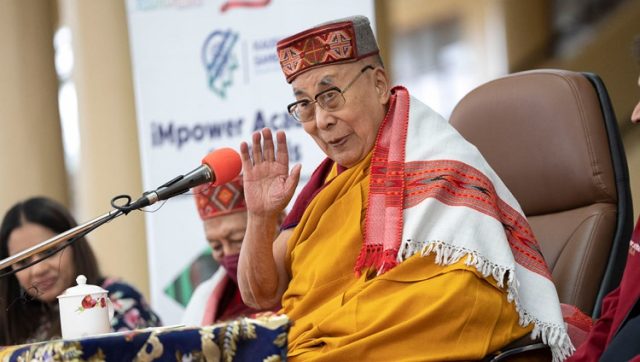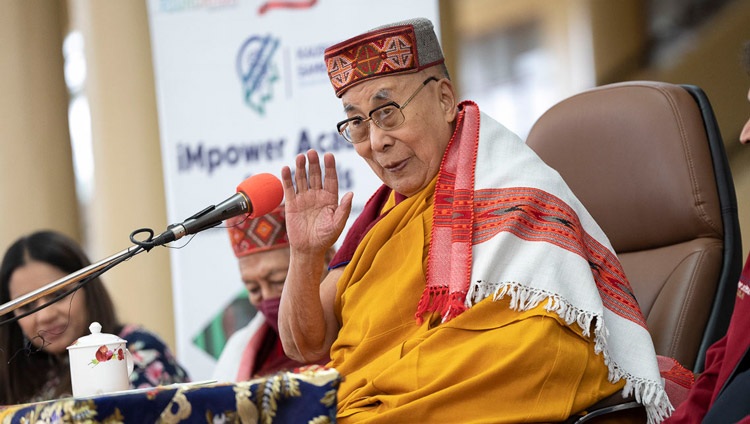
His Holiness the Dalai Lama wearing a traditional Himachali cap and shawl offered to him by the Chairman of M3M at the start of their meeting in the courtyard of the Main Tibetan Temple in Dharamsala, HP, India on February 28, 2023. Photo by Tenzin Choejor
The M3M Foundation, founded by the M3M India group, is working on equitable development to create a brighter India. It aims to introduce sustainable development and empower marginalized communities by focussing on education, health, livelihood and conservation of the environment. The foundation fosters life skills in the students under its care, encouraging them to value equality, empathy, inclusion, collaboration and trust.
Once His Holiness had taken his seat, the Chairman of M3M gave him a traditional Himachali welcome, offering him a cap and a shawl. Indicating five cows with their calves tethered nearby, he informed His Holiness that four are to be given to widows and one to a local school.
Invited to address the gathering, His Holiness declared:
“As human beings we are all brothers and sisters. But in addition to that, we Tibetans have long-standing special relations with India.
“In the seventh century, the Tibetan king, Songtsen Gampo married a Chinese princess and I’m sure enjoyed Chinese food. However, once he’d decided that Tibetans needed to learn to write, he chose to model the new Tibetan script on the Indian Devanagari alphabet rather than on Chinese characters.
“A century later, another Tibetan king, Trisong Detsen invited one of the foremost scholars of Nalanda University to Tibet. Shantarakshita introduced the vast knowledge of the Buddha-dharma that encompassed an understanding of everything from the smallest particle, to space and the workings of the mind.
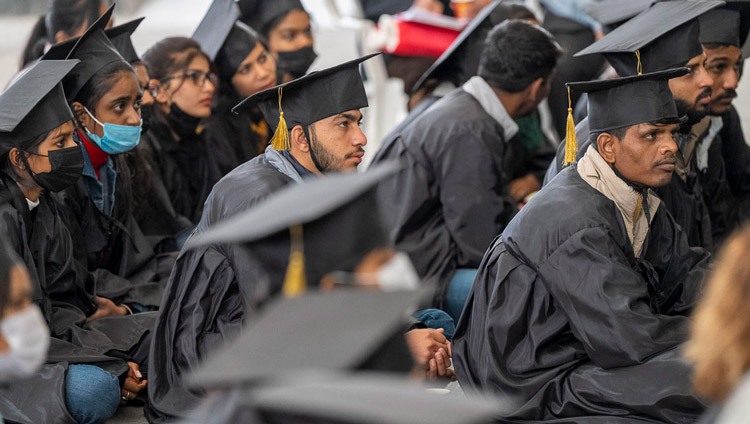
Recently graduated Indian college students in the audience listening to His Holiness the Dalai Lama speaking in the courtyard of the Main Tibetan Temple in Dharamsala, HP, India on February 28, 2023. Photo by Tenzin Choejor
“Sometimes I jokingly say that in times past we Tibetans were the students and you Indians were the teachers, but now, when Indian has come so much under the influence of western thought, it is we Tibetans who have kept ancient Indian knowledge and values alive. Essentially this involves karuna and ahimsa, compassion and non-harming or non-violence. Mind you, although we value karuna and ahimsa, we Tibetans remain powerful and strong. Karuna brings inner strength leading to inner peace, greater self-confidence and the ability to smile. It’s because I practise karuna,” and he laughed, “that I always smile.”
His Holiness further explained that, as a philosopher and logician, Shantarakshita’s approach to Buddhism was based on developing a gradual understanding founded on reason and logic. At the same time there were Chinese monks in Tibet who taught that quietist meditation was a more effective approach. King Trisong Detsen organized a debate between the Chinese monk Hashang and Shantarakshita’s disciple Kamalashila. In declaring the Indian scholar the winner, he gave his approval to his studious investigative and analytical approach. His Holiness mentioned that this was how he was brought up, beginning to learn about the workings of the mind and emotions when he was only four or five years old.
“Since I came to live in India, I’ve been able to meet all kinds of people, including scholars and scientists, who are interested in the methods for achieving peace of mind we have kept alive. I am convinced that if we are able to combine a command of technological development with a better understanding of the mind, we’ll be able to employ technology in a proper, healthy way. It’s a mistake, for example, to direct technological prowess primarily into the development of more sophisticated weapons. Science would be better used in pursuit of peace.
“All eight billion human beings alive today want to live in peace. It’s human nature to be affectionate. When we’re born, we survive and find peace in our mother’s care and attention. Then, as young children we accept others as they are. We don’t seek to identify differences between us. That’s something we learn to do later when we go to school, which can lead us to discriminate on the basis of ‘us’ and ‘them’.
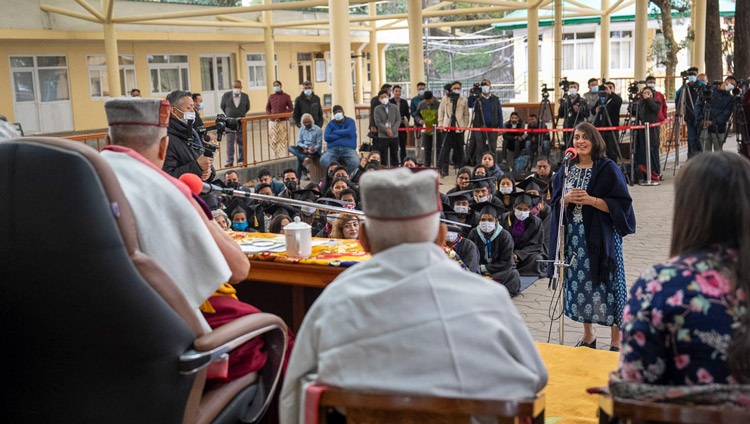
A member of the audience asking His Holiness the Dalai Lama a question during his talk to students and members of the M3M Foundation in the courtyard of the Main Tibetan Temple in Dharamsala, HP, India on February 28, 2023. Photo by Tenzin Choejor
“Since we are all human beings, we need to view each other as brothers and sisters. Relying on weapons to fight and kill brings nothing but destruction. Particularly sad is fighting in the name of religion, because at their core all religions teach compassion and loving-kindness.
“If we think in terms of the oneness of humanity, we can dispense with weapons and solve any differences between us through dialogue and discussion. We have to remind ourselves of what we have in common. We’re all born the same way and we all die the same way. I hope that in my lifetime we can create a genuinely peaceful world free of weapons and violent conflict.
“What’s more, since global warming is becoming so serious, we must learn to live happily together, helping one another, while we can.”
In answering questions from the audience His Holiness expressed an appreciation of the way so many diverse customs and points of view flourish in India and the people who hold them live peaceably together. This is something, he said, from which the world can learn.
He recommended encouraging young children to think less in terms of ‘I’ and more in terms of ‘we’. He repeated that the serious problems we face because of climate change mean we have to cooperate and work together. Ideas of ‘us’ and ‘them’ are out of date.
Finally, asked how to achieve spiritual growth, His Holiness observed:
“Many different emotions affect our minds. Some, like anger and fear, are disturbing; others like empathy and compassion bring joy. Nurturing positive emotions naturally helps reduce those that are destructive. As I’ve already mentioned, it’s compassion that leads to inner strength and peace of mind. Therefore, we have to constantly remind ourselves that as members of the same human family we are brothers and sisters. And we must follow the example of those good people who work for peace and not those who fight and kill.”
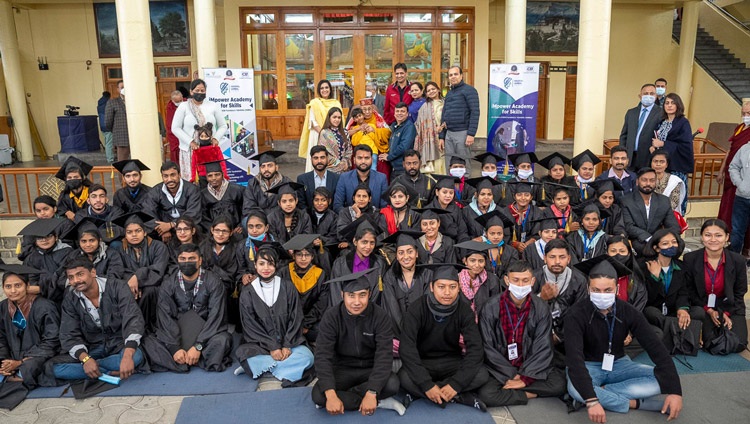
Members of the audience posing for a group photo with His Holiness the Dalai Lama at the end of the program in the courtyard of the Main Tibetan Temple in Dharamsala, HP, India on February 28, 2023. Photo by Tenzin Choejor
The various members of the group gathered round His Holiness to have photographs taken with him.
As he made to leave, but before he climbed into the golf-cart that would take him home, His Holiness stopped to inspect the cows that were going to be given away and said a few kind words to them.


